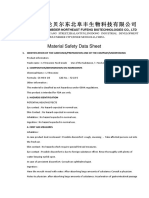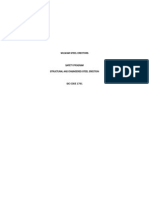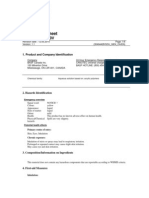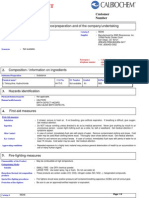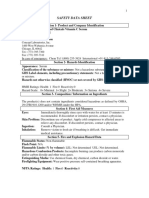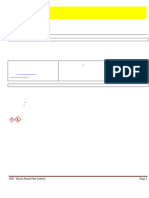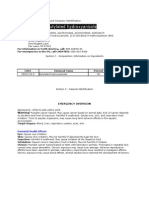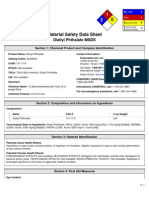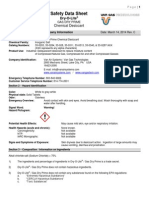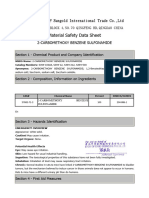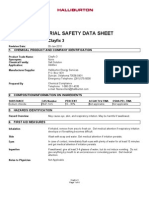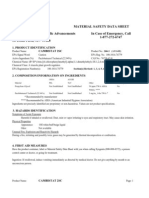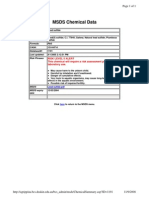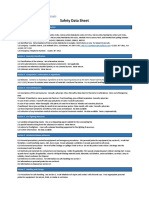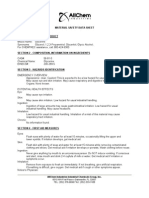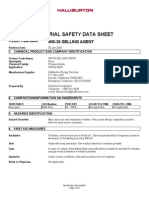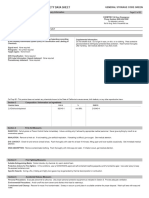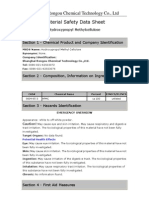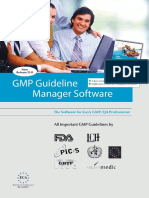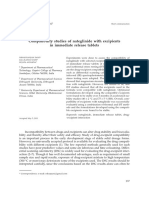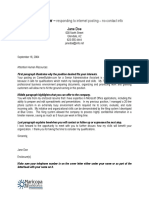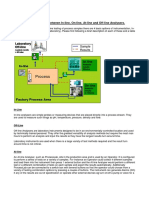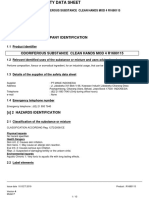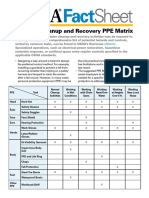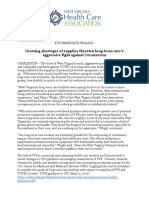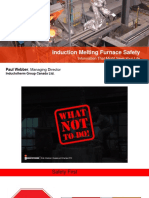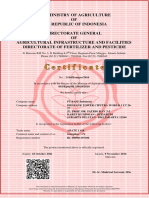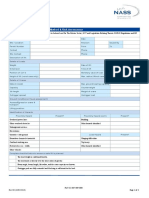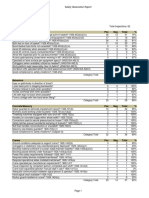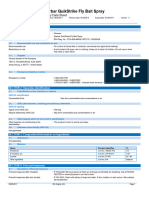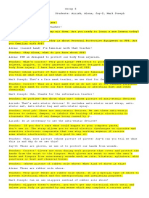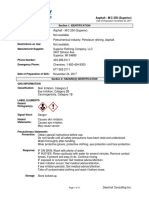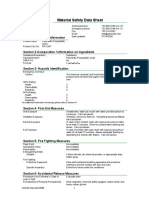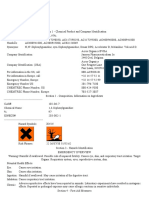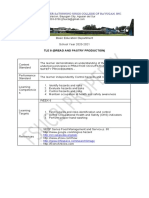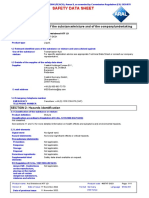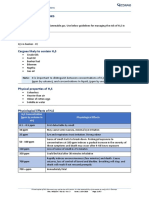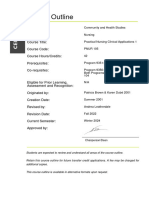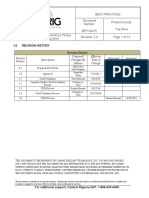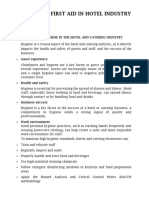1624 MSDS PDF
1624 MSDS PDF
Uploaded by
Mostofa RubalCopyright:
Available Formats
1624 MSDS PDF
1624 MSDS PDF
Uploaded by
Mostofa RubalOriginal Description:
Original Title
Copyright
Available Formats
Share this document
Did you find this document useful?
Is this content inappropriate?
Copyright:
Available Formats
1624 MSDS PDF
1624 MSDS PDF
Uploaded by
Mostofa RubalCopyright:
Available Formats
MATERIAL SAFETY DATA SHEET
Cat# 1624-100, -25, Lapatinib Ditosylate (Tykerb, Tyverb, GW-572016)
SECTION 1: PRODUCT AND COMPANY IDENTIFICATION PRODUCT NAME: PRODUCT CODES: MANUFACTURER: ADDRESS: Lapatinib Ditosylate (Tykerb, Tyverb, GW-572016) Cat# 1624-100, -25 BioVision, Inc. 155 S. Milpitas Boulevard, Milpitas, CA 95035
MSDS DATE: Feb 29, 2012
EMERGENCY PHONE: 858-373-8066 CHEMTREC PHONE: OTHER CALLS: 408-493-1800 FAX PHONE: 408-493-1801
SECTION 2: COMPOSITION/INFORMATION ON INGREDIENTS Component Lapatinib Ditosylate (Tykerb, Tyverb, GW-572016) SECTION 3: HAZARDS IDENTIFICATION Product Name/Chemical Name Lapatinib Ditosylate (Tykerb, Tyverb, GW-572016) CAS Number 388082-78-8 EC-No. -MW 925.46 Chemical Formula C29H26ClFN4O4S 2C7H8O3S Description Solid Volume 1624-100: 100 mg 1624-25: 25 mg Safety Information See below
Lapatinib Ditosylate (Tykerb, Tyverb, GW-572016): Emergency Overview OSHA Hazards: No known OSHA hazards GHS Classification: Not a dangerous substance according to GHS GHS Label elements, including precautionary statements Pictogram: none Signal word: none Hazard statement(s): none Precautionary statement(s): none HMIS Classification Health hazard: 0 Flammability: 0 Physical hazards: 0 NFPA Rating Health Hazard: 0 Fire: 0 Reactivity Hazard: 0 Potential Health Effects Inhalation: May be harmful if inhaled. May cause respiratory tract irritation. Skin: May be harmful if absorbed through skin. May cause skin irritation. Eyes: May cause eye irritation. Ingestion: May be harmful if swallowed. SECTION 4: FIRST AID MEASURES If inhaled: If breathed in, move person into fresh air. If not breathing, give artificial respiration. Consult a physician. In case of skin contact: Wash off with soap and plenty of water. Consult a physician. In case of eye contact: Rinse thoroughly with plenty of water for at least 15 minutes and consult a physician. If swallowed: Never give anything by mouth to an unconscious person. Rinse mouth with water. Consult a physician. 5: FIRE-FIGHTING MEASURES Condition of flammability: Not flammable or combustible. Suitable extinguishing media: Use water spray, alcohol-resistant foam, dry chemical or carbon dioxide. Special protective equipment for fire-fighters: Wear self-contained breathing apparatus for firefighting if necessary. Hazardous combustion products: Hazardous combustion products formed under fire conditions not available SECTION 6: ACCIDENTAL RELEASE MEASURES Personal precautions: Use personal protective equipment. Avoid dust formation. Avoid breathing vapors, mist, gas, or dust. Ensure adequate ventilation. Environmental precautions: Do not let product enter drains. PAGE 1 OF 3
MATERIAL SAFETY DATA SHEET
Cat# 1624-100, -25, Lapatinib Ditosylate (Tykerb, Tyverb, GW-572016)
SECTION 7: HANDLING AND STORAGE Precautions for safe handling Avoid contact with skin and eyes. Avoid formation of dust and aerosols. Provide appropriate exhaust ventilation at places where dust is formed. Normal measures for preventive fire protection. Conditions for safe storage Keep container tightly closed in a dry and well-ventilated place. Recommended storage temperature: -20C SECTION 8: EXPOSURE CONTROLS/PERSONAL PROTECTION Contains no substances with occupational exposure limit values. Personal protective equipment Respiratory protection Respiratory protection is not required. Where protection from nuisance levels of dusts are desired, use type N95 (US) or type P1 (EN 143) dust masks. Use respirators and components tested and approved under appropriate government standards such as NIOSH (US) or CEN (EU). Hand protection Handle with gloves. Gloves must be inspected prior to use. Use proper glove removal technique (without touching glove's outer surface) to avoid skin contact with this product. Dispose of contaminated gloves after use in accordance with applicable laws and good laboratory practices. Wash and dry hands. Eye protection Use equipment for eye protection tested and approved under appropriate government standards such as NIOSH (US) or EN 166(EU). Skin and body protection Choose body protection in relation to its type, to the concentration and amount of dangerous substance, and to the specific workplace. The type of protective equipment must be selected according to the concentration and amount of the dangerous substance at the specific workplace. Hygiene measures General industrial hygiene practice. SECTION 9: PHYSICAL AND CHEMICAL PROPERTIES Property Appearance: pH: Water Solubility: Other Solubility: Specific Gravity (g/ml): Boiling Point (C): Melting Point (C): Flash Point (C): Ignition Temperature (C): Density SECTION 10: STABILITY AND REACTIVITY Property Chemical stability Conditions to avoid: Materials to avoid: Hazardous decomposition products: SECTION 11: TOXICOLOGICAL INFORMATION Lapatinib Ditosylate (Tykerb, Tyverb, GW-572016): Acute toxicity: no data available Skin corrosion/irritation: no data available Serious eye damage/eye irritation: no data available Respiratory or skin sensitization: no data available Germ cell mutagenicity: no data available Carcinogenicity: IARC: No component of this product present at levels greater than or equal to 0.1% is identified as probable, possible or confirmed human carcinogen by IARC. ACGIH: No component of this product present at levels greater than or equal to 0.1% is identified as a carcinogen or potential carcinogen by ACGIH. PAGE 2 OF 3 Lapatinib Ditosylate (Tykerb, Tyverb, GW-572016) Stable under recommended storage conditions No data available Strong acids, strong bases Carbon oxides, nitrogen oxides Lapatinib Ditosylate (Tykerb, Tyverb, GW-572016) Yellow solid No data available Very poorly soluble (1-10 M) DMSO (200 mg/ml) No data available No data available 241-252 oC (465.8-485.6 oF) No data available No data available No data available
MSDS DATE: Feb 29, 2012
Methods for cleaning up: Pick up and arrange disposal without creating dust. Keep in suitable, closed containers for disposal.
MATERIAL SAFETY DATA SHEET
Cat# 1624-100, -25, Lapatinib Ditosylate (Tykerb, Tyverb, GW-572016)
NTP:
MSDS DATE: Feb 29, 2012
No component of this product present at levels greater than or equal to 0.1% is identified as a known or anticipated carcinogen by NTP. OSHA: No component of this product present at levels greater than or equal to 0.1% is identified as a carcinogen or potential carcinogen by OSHA. Reproductive toxicity: no data available Teratogenicity: no data available Specific target organ toxicity single exposure (GHS): no data available Specific target organ toxicity repeated exposure (GHS): no data available Aspiration hazard: no data available Potential Health Effects Inhalation: May be harmful if inhaled. May cause respiratory tract irritation. Skin: May be harmful if absorbed through skin. May cause skin irritation. Eyes: May cause eye irritation. Ingestion: May be harmful if swallowed. Signs and Symptoms of Exposure: Exposure may cause irritation to eyes, skin, mucous membranes, and upper respiratory tract. Ingestion may result in diarrhea, nausea, abdominal cramping, rash, and fatigue. To the best of our knowledge, the chemical, physical, and toxicological properties have not been thoroughly investigated. Synergistic effects: no data available Additional information: RTECS: not available SECTION 12: ECOLOGICAL INFORMATION Lapatinib Ditosylate (Tykerb, Tyverb, GW-572016): Persistence and degradability: no data available Toxicity: no data available Bioaccumulative potential: no data available Mobility in soil: no data available PBT and vPvB assessment: no data available Other adverse effects: no data available SECTION 13: DISPOSAL CONSIDERATIONS Product: Observe all federal, state, and local environmental regulations. Contaminated packaging: Dispose of as unused product. SECTION 14: TRANSPORT INFORMATION Lapatinib Ditosylate (Tykerb, Tyverb, GW-572016): DOT (US): Not dangerous goods. IMDG: Not dangerous goods. IATA: Not dangerous goods. SECTION 15: REGULATORY INFORMATION Lapatinib Ditosylate (Tykerb, Tyverb, GW-572016): OSHA Hazards: No known OSHA hazards SARA 302 Components: SARA 302: No chemical in this material are subject to the reporting requirements of SARA Title III, Section 302. SARA 313 Components: SARA 313: This material does not contain any chemical components with known CAS numbers that exceed the threshold (De Minimis) reporting levels established by SARA Title II, Section 313. SARA 311/312 Hazards: No SARA Hazards Massachusetts Right To Know Components: No components are subject to the Massachusetts Right to Know Act. Pennsylvania Right To Know Components: No components are subject to the Pennsylvania Right to Know Act. New Jersey Right To Know Components: No components are subject to the New Jersey Right to Know Act. California Prop. 65 Components: This product does not contain any chemicals known to State of California to cause cancer, birth defects, or any other reproductive harm. EU regulations Component Lapatinib Ditosylate (Tykerb, Tyverb, GW-572016) SECTION 16: OTHER INFORMATION DISCLAIMER: The above information is believed to be correct but does not purport to be all inclusive and shall be used only as a guide. The information in this document is based on the present state of our knowledge and is applicable to the product with regard to appropriate safety precautions. It does not represent any guarantee of the properties of the product. BioVision, Inc., shall not be held liable for any damage resulting from handling or from contact with the above product. See reverse side of invoice or packing slip for additional terms and conditions of sale. Risk Phrases R22 Safety Phrases S22, S24/25, S36/37
PAGE 3 OF 3
You might also like
- SDS15 0301 L Threonine 98pct Hulumbeier FufengDocument4 pagesSDS15 0301 L Threonine 98pct Hulumbeier FufengСветлана100% (1)
- CHS Module 4 - Install Computer Systems and NetworksDocument72 pagesCHS Module 4 - Install Computer Systems and NetworksLawrence Cada Nofies96% (55)
- Msds Reolution Res GelDocument5 pagesMsds Reolution Res GelAnonymous imqQ6hGNo ratings yet
- Material Safety Data Sheet Product Name: ADVA 380 MSDS ID Number: D-07036 MSDS Date: 05/30/2014Document4 pagesMaterial Safety Data Sheet Product Name: ADVA 380 MSDS ID Number: D-07036 MSDS Date: 05/30/2014Cusid eeNo ratings yet
- Frick Oil No 3 MSDS PDFDocument8 pagesFrick Oil No 3 MSDS PDFMahmoud Mohamed50% (2)
- Steel Erection Safety Program One ManualDocument82 pagesSteel Erection Safety Program One ManualHardeep SinghNo ratings yet
- MSDS - Stanbio GlukosaDocument4 pagesMSDS - Stanbio GlukosaDoni Eka PrasetiyoNo ratings yet
- MSDS Sodium Bicarbonate MalanDocument7 pagesMSDS Sodium Bicarbonate Malandhono vandieselNo ratings yet
- Progesterone MsdsDocument6 pagesProgesterone MsdsAjay6699No ratings yet
- Corn OilDocument5 pagesCorn OilRino Anugraha TriatmajaNo ratings yet
- Material Safety Data Sheet: Florisil AdsorbentDocument5 pagesMaterial Safety Data Sheet: Florisil AdsorbentYeyen Parida MyNo ratings yet
- Safety Data Sheet: Per GHS Standard FormatDocument6 pagesSafety Data Sheet: Per GHS Standard FormatM.MuthumanickamNo ratings yet
- MSDS - Stanbio SGOTDocument4 pagesMSDS - Stanbio SGOTDoni Eka PrasetiyoNo ratings yet
- Science Lab, 2013. Hal 1, 3 (MSDS Pot)Document5 pagesScience Lab, 2013. Hal 1, 3 (MSDS Pot)Anggraini Hari Nur IndahsariNo ratings yet
- Fluconazole MSDSDocument12 pagesFluconazole MSDSShyam YadavNo ratings yet
- Chemicals Zetag MSDS Antiprex N 40V - 0510Document6 pagesChemicals Zetag MSDS Antiprex N 40V - 0510PromagEnviro.comNo ratings yet
- Safety Data Sheet: Identification of The Substance/preparation and of The Company/undertakingDocument4 pagesSafety Data Sheet: Identification of The Substance/preparation and of The Company/undertakingIlhamNo ratings yet
- Msds Amilum PDFDocument5 pagesMsds Amilum PDF125090201111004100% (1)
- Material Safety Data Sheet PDFDocument4 pagesMaterial Safety Data Sheet PDFadminNo ratings yet
- Home Pest ControlDocument5 pagesHome Pest Controlkodja terramarinNo ratings yet
- MSDS - Stanbio SGPTDocument4 pagesMSDS - Stanbio SGPTDoni Eka PrasetiyoNo ratings yet
- MSDS Name: Butylated Hydroxyanisole: Emergency OverviewDocument6 pagesMSDS Name: Butylated Hydroxyanisole: Emergency OverviewAgilentechNo ratings yet
- Saccharin SodiumDocument6 pagesSaccharin Sodiumapi-263411629No ratings yet
- Antimony Trioxide - MSDSDocument6 pagesAntimony Trioxide - MSDSJodyNo ratings yet
- Bic Sodio Tongbai Malan MSDSDocument7 pagesBic Sodio Tongbai Malan MSDSFIORELLA VANESSA MAITA MUCHANo ratings yet
- Asam SinamatDocument5 pagesAsam SinamatSholekhah ArviyantiNo ratings yet
- MsdsDocument6 pagesMsdsscribdkthNo ratings yet
- Dry o Lite Msds SheetDocument4 pagesDry o Lite Msds Sheettr0798100% (1)
- Unifire Smoke Fluid Safety SheetDocument6 pagesUnifire Smoke Fluid Safety SheetRicardo Nuñez RicoNo ratings yet
- Santovac 5 SDS PDFDocument5 pagesSantovac 5 SDS PDFmanish_keswani01No ratings yet
- Copeland 32 PDFDocument2 pagesCopeland 32 PDFCarlos MartinezNo ratings yet
- Sigma-Aldrich: Material Safety Data SheetDocument5 pagesSigma-Aldrich: Material Safety Data SheetArif HışırNo ratings yet
- Material Safety Data Sheet: Malachite Green OxalateDocument5 pagesMaterial Safety Data Sheet: Malachite Green OxalatecarbouNo ratings yet
- Msds - Cbs Qingdao z&f SungoldDocument6 pagesMsds - Cbs Qingdao z&f SungoldsinisterszzNo ratings yet
- MSDS DuPont Chlorine DioxideDocument6 pagesMSDS DuPont Chlorine Dioxidemyxomatosis33No ratings yet
- MSDS - Stanbio Kolesterol TotalDocument4 pagesMSDS - Stanbio Kolesterol TotalDoni Eka PrasetiyoNo ratings yet
- BBK4019Document6 pagesBBK4019Tariq Khan OtmanzaiNo ratings yet
- (+) - Catechin, Hydrate MSDS: Section 1: Chemical Product and Company IdentificationDocument5 pages(+) - Catechin, Hydrate MSDS: Section 1: Chemical Product and Company IdentificationPulbere NeagraNo ratings yet
- Tinolux BBSDocument9 pagesTinolux BBSMoises Samuel PomaNo ratings yet
- Clay Fix 3Document6 pagesClay Fix 3ellsworsNo ratings yet
- MSDS - Stanbio TrigliseridaDocument4 pagesMSDS - Stanbio TrigliseridaDoni Eka Prasetiyo100% (1)
- Cambistat MSDSDocument5 pagesCambistat MSDSkyu9999No ratings yet
- MSDS PBSDocument7 pagesMSDS PBSBakir MaungNo ratings yet
- Sds-21-065-Rev-01-Microcystin-Adda 520011 Es Oh Saes 522015 520013 300702Document3 pagesSds-21-065-Rev-01-Microcystin-Adda 520011 Es Oh Saes 522015 520013 300702Luis Fernando Benites PrietoNo ratings yet
- Violeta Metilo EnglishDocument7 pagesVioleta Metilo EnglishMarielle RiveraNo ratings yet
- Glycerin (Humco)Document6 pagesGlycerin (Humco)Saqib AliNo ratings yet
- MSDS GG25Document6 pagesMSDS GG25yokohamafinechemicalNo ratings yet
- Wg-36 Gelling AgentDocument5 pagesWg-36 Gelling AgentkrahulNo ratings yet
- Safety Data Sheets-Poughkeepsie Middle School 1-69 of 70Document351 pagesSafety Data Sheets-Poughkeepsie Middle School 1-69 of 70walidNo ratings yet
- AntrakuinonDocument5 pagesAntrakuinonIlhamNo ratings yet
- CP-4601-46 MsdsDocument6 pagesCP-4601-46 MsdskapenziaNo ratings yet
- Material Safety Data Sheet: Phenolphthalein, IndicatorDocument5 pagesMaterial Safety Data Sheet: Phenolphthalein, IndicatorYomi MedaNo ratings yet
- Sage Extract, Water Soluble MSDS: Section 1: Chemical Product and Company IdentificationDocument5 pagesSage Extract, Water Soluble MSDS: Section 1: Chemical Product and Company IdentificationSulist AnaNo ratings yet
- Msds DibenzalasetonDocument5 pagesMsds DibenzalasetonFedi Rahman TaraNo ratings yet
- MsdsDocument5 pagesMsdsLukman Nul HakimNo ratings yet
- Chemicals Zetag MSDS Powder Magnafloc 338 - 0510Document6 pagesChemicals Zetag MSDS Powder Magnafloc 338 - 0510PromagEnviro.comNo ratings yet
- MSDS HPMCDocument7 pagesMSDS HPMCJAUHARULALMAKNUNNo ratings yet
- pzt-lead-zirconate-titanate-12626-81-2_sdsDocument9 pagespzt-lead-zirconate-titanate-12626-81-2_sdsAhmed WaelNo ratings yet
- A Consumerýs Dictionary of Household, Yard and Office Chemicals: Complete Information About Harmful and Desirable Chemicals Found in Everyday Home Products, Yard Poisons, and Office PollutersFrom EverandA Consumerýs Dictionary of Household, Yard and Office Chemicals: Complete Information About Harmful and Desirable Chemicals Found in Everyday Home Products, Yard Poisons, and Office PollutersNo ratings yet
- Legally Poisoned: How the Law Puts Us at Risk from ToxicantsFrom EverandLegally Poisoned: How the Law Puts Us at Risk from ToxicantsNo ratings yet
- Georgia Pest Management Handbook: 2021 Home and Garden EditionFrom EverandGeorgia Pest Management Handbook: 2021 Home and Garden EditionEmily CabreraNo ratings yet
- WHO :technical Report Series:929 (Eng)Document152 pagesWHO :technical Report Series:929 (Eng)Sujan BoseNo ratings yet
- PSEAsia2013 99 PDFDocument6 pagesPSEAsia2013 99 PDFMostofa RubalNo ratings yet
- GMP Navi NeutralDocument4 pagesGMP Navi NeutralMostofa RubalNo ratings yet
- Compatibility Studies of Nateglinide With Excipients in Immediate Release TabletsDocument11 pagesCompatibility Studies of Nateglinide With Excipients in Immediate Release TabletsMostofa RubalNo ratings yet
- Sample Cover Letter - : Responding To Internet Posting - No Contact Info Jane DoeDocument4 pagesSample Cover Letter - : Responding To Internet Posting - No Contact Info Jane DoeMostofa RubalNo ratings yet
- MEP Inline On Line at Line Off Line AnalysersDocument3 pagesMEP Inline On Line at Line Off Line AnalysersMostofa RubalNo ratings yet
- FlutamideDocument32 pagesFlutamideMostofa RubalNo ratings yet
- Glass Delamination Risks Reality and RegulatoriesDocument42 pagesGlass Delamination Risks Reality and RegulatoriesMostofa Rubal100% (1)
- Published by SRL - Via Mario Donati, 6 - 20146 Milano (Italy)Document12 pagesPublished by SRL - Via Mario Donati, 6 - 20146 Milano (Italy)Mostofa RubalNo ratings yet
- Setting OELs, DR Robert Susman, SafebridgeDocument38 pagesSetting OELs, DR Robert Susman, SafebridgeMostofa RubalNo ratings yet
- Deshbibhag Fire Dekha by Ahmad RafiqueDocument483 pagesDeshbibhag Fire Dekha by Ahmad RafiqueMostofa Rubal0% (1)
- APA 6 BGS Qualitative Research Proposal August 20141Document33 pagesAPA 6 BGS Qualitative Research Proposal August 20141Mostofa RubalNo ratings yet
- MSDS Multipox MX-94 Traffic YellowDocument4 pagesMSDS Multipox MX-94 Traffic Yelloweva andriana putriNo ratings yet
- Odoriferous Substance Clean Hands Mod 4 R1680115Document15 pagesOdoriferous Substance Clean Hands Mod 4 R1680115Jamaila GanozaNo ratings yet
- CPCCCA3006 - Learner Guide V1.0Document40 pagesCPCCCA3006 - Learner Guide V1.0Aditya SharmaNo ratings yet
- Sheet: Disaster Cleanup and Recovery PPE MatrixDocument2 pagesSheet: Disaster Cleanup and Recovery PPE MatrixBorislav VulićNo ratings yet
- WVHCA Statement Ppe 4 10 20Document2 pagesWVHCA Statement Ppe 4 10 20Becca SchimmelNo ratings yet
- Sebu8076-05-01-All O&mDocument168 pagesSebu8076-05-01-All O&mrafaelNo ratings yet
- Sigma-Aldrich: Poly (Methyl Methacrylate)Document6 pagesSigma-Aldrich: Poly (Methyl Methacrylate)lusoegyi 1919No ratings yet
- Paul Webber Induction Furnance SafetyDocument38 pagesPaul Webber Induction Furnance SafetyPSS PrasadNo ratings yet
- Abate 1GDocument21 pagesAbate 1GAmman BilleNo ratings yet
- Mobile Crane Permit, Lifting Plan Method & Risk AssessmentDocument3 pagesMobile Crane Permit, Lifting Plan Method & Risk AssessmentfaizelNo ratings yet
- Safety Observation Report FormatDocument6 pagesSafety Observation Report FormatManthan VekariyaNo ratings yet
- Las Q4 W1 Dressmaking 8Document7 pagesLas Q4 W1 Dressmaking 8Houstine ErisareNo ratings yet
- Starbar QuikStrike Fly Bait Spray SDSDocument6 pagesStarbar QuikStrike Fly Bait Spray SDSAlMarzouk ShivaNo ratings yet
- Group 5 ScriptDocument2 pagesGroup 5 ScriptMargarette GalangNo ratings yet
- Asphalt - MC 250 (Superior) - Superior Refining Company, LLC (Husky Energy)Document11 pagesAsphalt - MC 250 (Superior) - Superior Refining Company, LLC (Husky Energy)Lindsey BondNo ratings yet
- Material Safety Data Sheet: Section 1-Product InformationDocument3 pagesMaterial Safety Data Sheet: Section 1-Product Informationhasan basriNo ratings yet
- 1 3-Diphenylguanidine (DPG)Document4 pages1 3-Diphenylguanidine (DPG)Huỳnh TGNo ratings yet
- Role of Safety OfficerDocument19 pagesRole of Safety OfficerRaDaCa CabsNo ratings yet
- Dry o Lite Msds SheetDocument4 pagesDry o Lite Msds Sheettr0798100% (1)
- Week 6 Bread and PastryDocument18 pagesWeek 6 Bread and PastryLiza Laith Lizzeth0% (1)
- Aral Getriebeoel Atf LD Germany English-Gb SDB 466747Document11 pagesAral Getriebeoel Atf LD Germany English-Gb SDB 466747Техник СвязиNo ratings yet
- Managing The Risk of H2SDocument5 pagesManaging The Risk of H2Ssandeepkumar2311No ratings yet
- MS-As-FRM-0063 Job Hazard Analysis Worksheet FormDocument3 pagesMS-As-FRM-0063 Job Hazard Analysis Worksheet Formأم رهامNo ratings yet
- Course OutlineDocument25 pagesCourse OutlinewilliamsdevanelNo ratings yet
- Standard Operating Procedures Truck Loading and Unloading OperationsDocument11 pagesStandard Operating Procedures Truck Loading and Unloading OperationsmohanggaNo ratings yet
- BP TD Torque Test ProcudereDocument13 pagesBP TD Torque Test ProcudereHugo MoralesNo ratings yet
- CLGB320 (Double-Cylinder) Operation Manual 201307000-ENDocument95 pagesCLGB320 (Double-Cylinder) Operation Manual 201307000-ENNorbert Hernandez100% (1)
- Hygiene-first Aid - Bvoc Sem iDocument23 pagesHygiene-first Aid - Bvoc Sem iarundhatin29No ratings yet
